
Some commentary about the National Space Council’s inaugural meeting (part 2)by Mike Snead
|
| Building infrastructure is not what NASA had in mind when it undertook the Space Launch System and the Orion spacecraft development. It is important that these not be thought of as, by themselves, logistics infrastructure. |
Panel 1, civil space, was the leaders of three prominent American aerospace companies: Marillyn Hewson of Lockheed Martin; Dennis Muilenburg of Boeing, and David Thompson of Orbital ATK. Given the time available and the council membership, their prepared remarks were general in nature, endorsing the reconstitution of the Council and its leadership role. Hewson called for “clear and strong government leadership, visionary programs, and stable, sustained investment.” Muilenburg called for “a bold national space agenda with clear, actionable objectives and resources.” Thompson foresees “a new golden age of space achievement if we are bold in our aspirations and resolute in our actions.” In short, these three aerospace business leaders see substantial business opportunity ahead for America in space.
In his prepared statement, Thompson noted, “As the space agency plans and implements our return to cislunar space, it should aggressively engage with US commercial enterprises that are willing to privately develop and operate systems that can provide a range of in-space utilities, logistics, and related services.” [Segment 7]
Later in the council discussions, the term “sustainability” arose with regard to American human spacefaring operations. Recognition of the importance of sustainability marks an important transition point in thinking of future human operations in space. At least within Earth-Moon space, we are no longer solely planning for exploration, but for operational continuity. Operational continuity requires “utilities, logistics, and related services”. Building this “spacefaring logistics infrastructure” is necessary to enable America’s transformation into a true human spacefaring nation.
Building infrastructure is not what NASA had in mind when it undertook the Space Launch System (SLS) and the Orion spacecraft development. It is important that these not be thought of as, by themselves, logistics infrastructure, especially when formulating General H.R. McMaster’s space strategic framework. While the SLS and Orion can be incorporated as elements of an integrated spacefaring logistics infrastructure, this infrastructure must be more comprehensive in scope and operational capability. In developing the part of the space strategic framework addressing human Earth-Moon space operations, defining an integrated logistics architecture should be an early planning step. Logistics planning is, inherently, strategic in nature and its planning must start on day one.
As recognition of the need for an integrated spacefaring logistics infrastructure grows, careful consideration should be given to how this is to be undertaken. Some on the Council may automatically turn to NASA to do this and, I’m sure, many within NASA would eagerly raise their hands to volunteer. Earlier this year, I explained my reasons why this should not be a NASA responsibility (see “Should NASA build spacefaring logistics infrastructure?”, The Space Review, January 9, 2017). This article explains the approach that I recommend, one that is fully consistent with America transitioning from a space-exploring to a true human spacefaring nation. To start this infrastructure planning, I recommend that the National Space Council form a Spacefaring Logistics Advisory Panel, perhaps subordinate to the Council’s Advisory Group, to address logistics needs and solutions in an orderly, integrated manner while developing plans and policies.
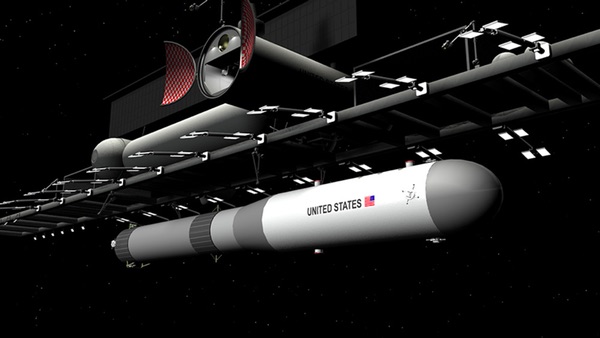 Space Launch System delivering a large payload to a LEO space logistics base’s space dock. |
I advocate for expanding the use of the SLS in an uncrewed capacity. Every effective transportation infrastructure has the ability to transport heavy and oversize payloads and equipment. While the SLS is being developed to launch crewed Orion spacecraft on deep space missions, it obviously has the ability to transport uncrewed payloads to Earth orbit. Thompson called for “NASA and its industrial partners… to substantially accelerate the use and to fully exploit the capabilities of the SLS/Orion system.” The uncrewed use of the SLS is a common-sense exploitation of the system. It will lower per-mission costs, strengthen the supply chain, and improve confidence in mission success when used for deep space crewed missions.
| If America is to become a true commercial human spacefaring nation, reasonable expectations about the safety of involved Americans must be met. This raises two important topics: What is meant by “safety” and how should this be achieved? |
As mentioned in Part 1, McMaster is leading the development of a space strategic framework. My presumption is that this framework will set the boundaries for America’s space enterprise over the next several decades. The use of the SLS will likely be incorporated into this framework. The expected use of the SLS for both deep space crewed missions as well as uncrewed payload missions should be planned to fully exploit the nation’s investment in this launch system. The ability of the SLS to place 100-ton assemblies into Earth orbit will be a spacefaring operational game-changer. This short video illustrates what can be done using the SLS as an unmanned launch system. (Note that the SLS core is reused in building some of these logistics capabilities, thereby enhancing the cost-effectiveness and operational utility of expanding the use of the SLS.)
With the SLS becoming operational within several years, beginning to build substantial logistics facilities in low Earth orbit can begin shortly thereafter. Contractor assembly and initial government/contractor operational crews can be transported using the commercial crew systems being developed by NASA. Within six to seven years, the United States can build significant LEO logistics infrastructure capabilities that will enhance current and enable significant new civil, commercial, and national security human and robotic operations.
Panel 2, commercial space, was the leaders of three additional American aerospace companies: Gwynne Shotwell of SpaceX), Bob Smith of Blue Origin, and Fatih Ozmen of Sierra Nevada Corporation.
As mentioned by Vice President Pence and several speakers, America’s future in outer space is changing—at least within Earth-Moon space—from temporary human exploration to permanence. In undertaking this transition, the protection of the safety of Americans traveling to and working and living within Earth-Moon space becomes a policy and planning priority. If America is to become a true commercial human spacefaring nation, reasonable expectations about the safety of involved Americans must be met. This raises two important topics: What is meant by “safety” and how should this be achieved?
Common law places a “duty to care” burden on a business owner, making them legally responsible for the safety of their customers. The duty to care obligation means that the business owner must take reasonable steps to prevent harm coming to their customers. Should a customer be injured or killed, the owner can be sued for damages, including punitive damages if negligence is demonstrated. With gross negligence, the business owner may be held criminally liable.
Not being a lawyer, it is my understanding that offering transportation services to paying customers—referred to as passengers under common law—automatically creates the duty to care obligation and legal liabilities. Thus, when business owners or representatives discuss future space passenger services, my expectation is that the duty-to-care obligation is in play whether they mention it or not. How this duty-to-care obligation is to be met is a very important early space policy and planning issue.
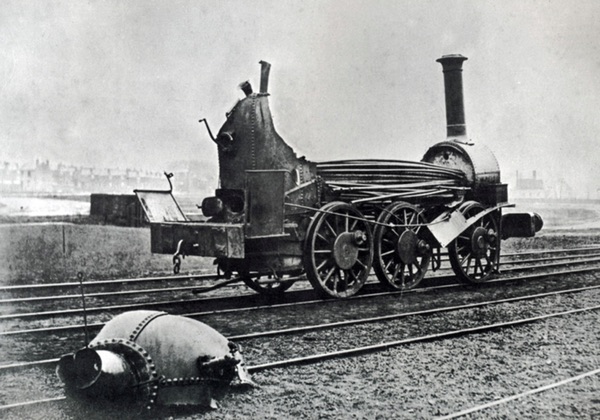 Exploded boiler on a railroad locomotive. |
When the steam-powered industrial age began in the mid-1800s, safety was, under common law, left to the responsibility of the business owner. As America industrialized, technology advancement was rapid with companies quickly adopting new technologies to gain advantage. This technology advancement was not without problems: cables broke, boilers exploded, track rails broke or twisted, bridges collapsed. Just after the end of the Civil War, just days after President Lincoln was assassinated, the boiler on a steamboat on the Mississippi River exploded due to an inadequate repair. Nearly 1,200 people died. A factory boiler explosion in 1905 killed 58 people. In Boston in 1919, an extremely large molasses storage tank structurally failed, with the ensuing molasses flood killing 21 people. Litigation to sue for harm and damages was common and burdensome, even more so than today as it was the only recourse for the impacted public.
As scientific and engineering expertise grew, a federal regulatory approach of independent safety certification arose as the primary means for assuring the public’s safety. Through independent certification, absent negligence, the business owner could show that the duty-to-care obligation was faithfully met. Lawsuits alleging harm would then likely be dismissed. Essentially, public law and regulation, periodically updated to reflect new scientific knowledge and lessons-learned, defined what was an acceptable level of safety preparedness.
Federal safety regulation began with railroads, moved into steam boilers, food, drugs, and, in the 1920s, into the aircraft industry with the federal airworthiness certification process. The federal government recognized that for the airline industry to advance and prosper, the public must have acceptable confidence that the safety of the passengers, as well as people on the ground, were being reasonably protected to the best of the ability of the available scientific and engineering knowledge. I argue that federal airworthiness certification made the airline industry what it is today and is the highly-successful model that should now be extended to both government and commercial non-exploratory human spaceflight within Earth-Moon space. This is not, however, the path commercial human spaceflight is now on. A flight approval process based on what is referred to as “informed consent” is what is being followed today.
Quite often, expanding the human domain of operations and knowledge requires individual courageous action. The Wright Brothers repeatedly demonstrated their personal courage as they originated and expanded the realm of powered, controlled flight. When someone talks of the notion of informed consent, the Wright Brothers were certainly most knowledgeable about the risks of flight at the time. Yet, with only one exception per my understanding, did the two brothers ever fly together as they well understood the risks they were accepting. In my view, this is a good example of what informed consent really means—having experience and sufficient technical understanding to properly consent to accept the risk.
| I am not arguing that these two commercial crew astronaut transportation systems are not needed, only that the public should not be led to believe that they are suitable for commercial passenger transportation. |
Every new crewed aircraft first flies with a test pilot. As aircraft became more sophisticated, test pilots started to work with the aircraft designers during the design phase to guide important human factors considerations and to fully understand the design and operation of the aircraft. This was how test pilots became informed of the risks involved in flying the aircraft, enabling the pilots to undertake special preparatory training or to, in some cases, quit if the risks were judged too great. (As a government engineer observer, I saw a test pilot quit a program after a ground test failure mandated by the government. That program was eventually cancelled.) For a test pilot to be able to exercise informed consent, they must be properly informed and have the technical and flight experience to judge the risks.
When the US human spaceflight program began in the 1960s, President Kennedy’s call for an aggressive Moon landing within a decade forced the use of a transportation architecture built on expendable launch systems. The astronauts selected for the Mercury program were experienced military test pilots and, often, combat pilots. (In the 1950s, being a military test pilot was far more hazardous than today.) With the risk of flight on converted ballistic missiles being clear to the public, the astronaut’s safety was addressed with the notion of “man-rating” these expendable munitions. The public was told that the astronauts selected had the “right stuff” to accept the obvious risks.
All of the Mercury, Gemini, and Apollo astronauts had the right stuff—enabling America to fulfill President Kennedy’s bold goal. Yet, we lost three astronauts in the Apollo 1 on-pad accident and nearly lost the Apollo 13 astronauts in flight. A low flight rate and great care in the manufacturing, preparation, and launch of these missions contributed to the overall success. However, I don’t think anyone would argue that we were not lucky. Nor would anyone argue that many people, with self-defined duties to community and country, today also have the right stuff: fire fighters, police officers, military combat forces, and so on. “Right stuff” operations are, obviously, outside the bounds of normal, commercial human operations.
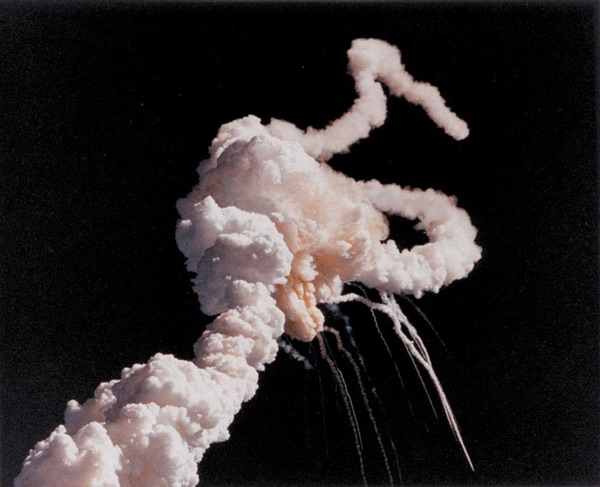 Loss of the Space Shuttle Challenger in 1986. |
The Space Shuttle program was to replace the risks of the expendable-based transportation architecture with a fully-reusable, two-stage system aimed at routine, frequent space access. Turnaround time was to be two weeks. These was part of the system requirements defined in 1970. However, budgetary pressures in 1972 forced a shift to the partially-reusable system that was built. Flight safety returned to a “man-rated” approach that was often conflated as being equivalent to airline airworthiness certification when, obviously, it is not. The man-rated approach accepts the mission use of flight-critical mission hardware that has not been flight tested as part of a safety certification process. In the instance of the Space Shuttle, these were the external tank and solid rocket boosters—both of which were the primary causes of the two shuttle mission failures.
The following figure was prepared by NASA after the end of Space Shuttle operations. It shows the calculated probability of mission failure throughout the 30-year flight history. While I applaud NASA for undertaking this effort and releasing the results to the public, this was released only after Shuttle operations ended.
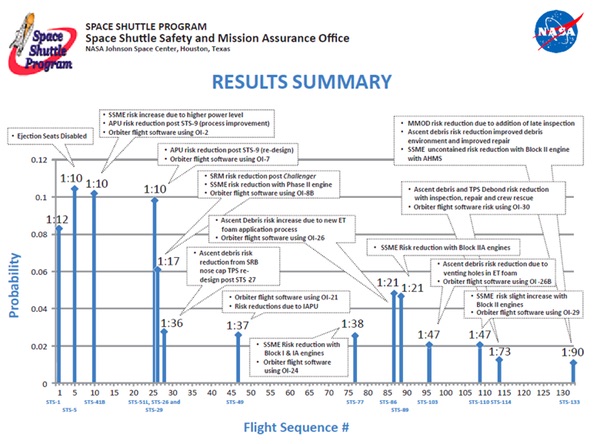 Loss of the Space Shuttle Challenger in 1986. |
Up through the loss of the Challenger in 1985, the mission probability of failure for this man-rated system was only one in ten (1:10). By the time of the loss of Challenger, the cumulative probability of loss was nearly 100 percent. We are all aware of the poor decisions made to release the Challenger for flight. However, even without the circumstances causing those poor decisions, the system still had roughly a ten percent probability of failure. At best, at the end of the operational life, the individual mission probability of failure only improved to 1:90, orders of magnitude less than what is considered minimally acceptable in the world of normal commercial human safety protection.
NASA astronauts are legally not passengers, meaning that neither NASA nor the companies that provide it with human launch services are, to my understanding, subject to the common law duty-to-care obligation. NASA is now funding the commercial crew program to provide domestic astronaut transport to the International Space Station. The SLS and the Orion spacecraft are being developed to transport NASA astronauts on deep-space missions. On these missions, NASA’s only real safety obligation is to do what is necessary to maintain Congressional funding. I am not arguing that these two astronaut transportation systems are not needed, only that the public should not be led to believe that they are suitable for commercial passenger transportation. NASA astronauts, it is assumed, have the technical knowledge and experience to make an informed decision; passengers, obviously, do not. Hence, the time-tested need for the duty to care obligation remains for forthcoming commercial passenger space travel.
In her prepared remarks, Shotwell discussed SpaceX’s plans to build a “rocket and a spaceship capable of carrying large numbers of humans to Mars as well as the surface of the Moon.” [Segment 33] In his prepared remarks, Smith spoke of Blue Origin’s New Glenn rocket “taking people and payloads to low-Earth orbit and beyond.” Later adding, “our New Glenn launch vehicle will be more capable than existing launch vehicles flying today and can be used not only for human spaceflight and other commercial missions but also for civil and national security payloads.” [Segment 35]
The implications of their carefully-chosen prepared words are clear. Shotwell and Smith are implying the use of their rockets for transporting passengers to space. In response to a question, Smith remarked, “So, within the next 18 months we’re going to be launching humans into space and this won’t be astronauts, people that have been trained and specialized within an area, but these are going to be everyday citizens.” [Segment 50] How will these “everyday citizens”, who have not been “trained and specialized” for human spaceflight on Blue Origin’s launch systems, make an informed consent about their personal safety? Is this a reasonable expectation of everyday citizens or a legalistic way to try to skirt the duty-to-care obligation?
 Composite radar snapshot of commercial airliners flying on a typical morning or afternoon. |
The above image is a snapshot of the commercial airliners in the sky above the contiguous United States on a typical morning or afternoon. Perhaps as many as one million everyday citizens are flying on about 5,000 airliners at altitudes of more than 10,000 meters. At that altitude, the outside conditions will bring quick death, not unlike spaceflight. Yet, our airworthiness-regulated airline industry has made this mode of public transportation so safe that parents routinely send their children on flights unaccompanied to travel to see family and friends. This is the level of safety which, for commercial human spaceflight, registered professional engineers have an ethical obligation to strive to meet or the government needs to assure passenger safety through independent safety certification.
In response to a question, Shotwell remarked, “I do believe strongly that once you put people, massive amounts of people in low Earth orbit and beyond, the space enterprise will proliferate in ways that we can’t even imagine right now.” [Segment 51]
I agree that as America transitions to a true human spacefaring nation, large numbers of everyday citizens will be traveling to, living in, and working in outer space. Most will be private citizens, employed to conduct work in space or undertaking private business or leisure in space. But for this to happen, commercial common law will need to apply to protect the safety of these everyday citizens during their trip into space.
The council, through its policy and plans recommendations to the President, should be clear that the common law duty-to-care obligation for protecting the safety of Americans engaged in commercial space operations will be the legal basis for approving American commercial human spacefaring operations. As discussed in the following, I recommend this duty-to-care obligation be met through airworthiness certification.
Several companies are preparing to transport spaceflight participants—legally not passengers—on suborbital flights into space. Per my understanding, the legal model applied by federal legislation is that of entertainment travel, such as whitewater rafting.
| The National Space Council will, through action or inaction, address this key issue in their development of policies and plans for American commercial development in space. Extending this spaceflight participant approach to human space transportation is obviously flawed. |
Entertainment travel is where the means of travel is the reason for the trip. Whitewater rafting as entertainment travel is largely unregulated. There may be simple regulations, such as wearing a life vest and helmet and not permitting a minor to go on the trip without written permission by the parent or guardian. But, for a joyride on the river, the law presumes the adult is sufficiently competent to judge whether sufficient safety is being provided—is the water level too high, the raft in good condition, et cetera.? However, using the same rafting company to provide transportation to a destination downriver would make this a passenger service subject to the duty-to-care obligation.
No form of public passenger transportation falls in the category of entertainment travel even though the trip may, for some, have entertainment value—such as a glass-enclosed elevator on the outside of a building. Further, many forms of entertainment travel, usually amusement park rides, are fully regulated and frequently inspected.
As mentioned, Congress and some states have, through legislation, put suborbital commercial human spaceflight legally in the category of entertainment travel. The rational apparently was that, like whitewater rafting, people would do it for its entertainment value. Thus, a person on such a trip is legally called a “spaceflight participant,” not a passenger. Further, by law, they must sign an informed consent agreement absolving the business and the federal government of any liability. If they are killed or injured, c’est la vie. As Smith noted, these are “everyday citizens,” not people “trained or specialized” for spaceflight. In my view, the complexity of the means of transportation, the immaturity of the flight systems, the apparent lack of independent safety assuredness, and the unfamiliarity of the public with actually using this means of transportation makes the legal rational for equating suborbital spaceflight to whitewater rafting without merit.
Where commercial suborbital human spaceflight may run into legal trouble is when people utilize this as a transportation system to reach zero-g flight outside the atmosphere to conduct business. Perhaps, a research scientist wishes to conduct an experiment requiring a human to be present to operate the equipment. Again, not being a lawyer, in the case of harm, courts may find that the underlying legal rational absolving the spaceflight company (and its supply chain) of responsibility may be invalidated. After all, if the airline transporting the researcher to the launch site and back home is held responsible, why wouldn’t the spaceflight company transporting the researcher to space and back be held responsible? Even more important, turn the argument around. If the spaceflight company is not to be held responsible by the government, why should the airline company be held responsible?
Those advocating for this spaceflight participant approach appear to have disregarded ethical obligations for protecting human safety in the quest for just getting people into space quickly. Now, it is increasingly apparent that some companies involved in the quest for commercializing human space access wish to extend this flawed approach to commercial human transportation to, from, and within space. Under this presumed legal protection, they are developing commercial human transportation systems with the intent, as Smith said, of taking “everyday citizens” to space. The inference is that they wish to do this under the legal protection afforded by federal law mandating an informed consent waiving the usual passenger duty-to-care obligation.
The National Space Council will, through action or inaction, address this key issue in their development of policies and plans for American commercial development in space. Extending this spaceflight participant approach to human space transportation is obviously flawed. It would, as a discussion example, permit a company to resurrect the Space Shuttle system and use it to transport spaceflight participants to Earth orbit. The fact that the system had a one percent or greater chance of mission failure and loss of life would be ignored as long as an informed consent was given. Is this flawed reasoning a sound basis for developing a national plan to transform America into a true commercial human spacefaring nation? Obviously not!
Safety requirements significantly constrain the design, manufacturing, and operation of commercial passenger transportation systems. This is because meeting the duty to care obligation is paramount—as, ethically, it should be. A business engaged in unethical activities should be barred from public commerce. However, even for ethical companies, meeting the duty-to-care burden is often challenging.
For companies discussing future everyday citizen space travel, an important question is: Who in the company decides that the duty-to-care burden has been satisfactorily met? Who will be able, in a court of law under oath, to describe how the company faithfully discharged its duty to care obligation? In many forms of commerce, this responsibility falls on registered professional engineers, licensed by states, to protect public safety as their primary legal responsibility. The protection of the safety of everyday citizens traveling in space, certainly, should not be certified by professionally-unqualified people, including, possibly, the owners and officers of the company. In my view, pronouncements of forthcoming everyday citizen space travel should be met with skepticism, requests for supporting technical information, and requests for identification of specifically who in the company is qualified and bears the legal responsibility for safety.
Everyone has noticed the safety certificate, often posted in an elevator, attesting to its safety as determined by some government agency. Every form of public passenger transportation has some form of an independent safety certification process. For private, commercial, and military aircraft, federal law and regulations require that the duty-to-care obligation be met through independent verification undertaken by government agencies. This is referred to as airworthiness certification.
| Some companies are now mentioning “reusability” as a characteristic of their human space transportation system. This was done several times in the first council meeting. However, there was no mention of the need for airworthiness certification. |
For the United States to be successful in its transition into a true commercial human spacefaring nation, its non-exploration human transportation and habitation space systems must be safety-certified through an appropriate airworthiness certification process. (Note that versions of the phrase “spaceworthiness” have previously been used, so it is not appropriate to invite confusion by using spaceworthiness to describe the needed safety assurance process. However, using “spacefaring safety certification” may be acceptable.) Thus, commercial passenger systems used to transport “everyday citizens” to, from, and within space, as well as the habitats they will use to live in and work in, including spacesuits, should only enter commercial use after independent airworthiness certification has been achieved. Essentially, everything off terra firma used in commercial operations will need formal spacefaring safety certification.
No panel speaker mentioned or council member asked how the ethical duty-to-care obligation would be met for systems intended for transporting to or housing everyday citizens in space. This indicates a possible lack of appreciation of the importance of this issue and, thus, the reason why I have addressed it in this commentary. Public pronouncements of future commercial spacefaring capabilities, without explanation of how the duty to care safety obligation is to be met, lack sufficient detail for serious consideration or use as a basis for national spacefaring planning. Due to the importance of safety, I recommend that the National Space Council form a Spacefaring Safety Advisory Panel, perhaps subordinate to the Council’s Advisory Group, to address safety needs and certification in an orderly, integrated manner while developing plans and policies.
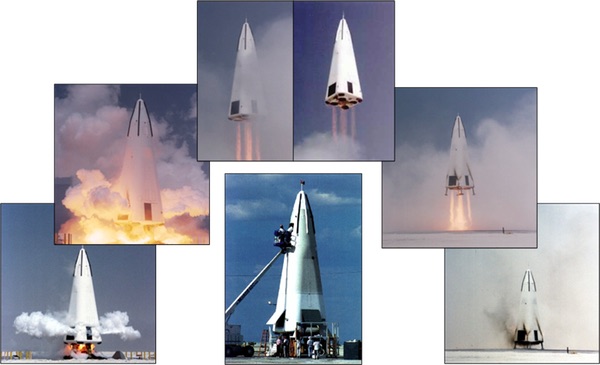 McDonnell Douglas Delta Clipper Experimental (DC-X). |
In the early 1990s, an important pathfinding demonstration project was undertaken: the Delta Clipper Experimental, or DC-X. The purpose of the 12-meter-tall, uncrewed, reusable rocket was to demonstrate aircraft-like operations with a rocket-powered vehicle. The above sequence shows an early flight, from takeoff on the left to landing on the right. In later flights, the demonstrator reached altitudes of 3,000 meters before descending back, under power, to a controlled touchdown. Using RL-10 engines, fueled with liquid hydrogen and liquid oxygen, an eight-hour turn-around time was demonstrated. The DC-X was a subscale version of a single-stage-to-orbit reusable space access system proposed by McDonnell Douglas. The DC-X preceded the similar SpaceX and Blue Origin efforts by about 25 years.
The notion of reusable space access has been around since the 1920s. Actual US conceptual design studies for reusable systems—referred to as aerospaceplanes—began in the late 1950s. From the very beginning, these were considered to be advanced aircraft in design and operation. While most were winged vehicles, later vertical takeoff and landing systems, not needing wings, were proposed. However, everyone understood that advanced aircraft were being studied, not an expendable launch system capable of being reused. This is an important engineering distinction that has now been blurred by the increasingly general use of the term “reusable” to incorrectly imply aircraft-like safety and operability. This is similar to, as noted earlier, the use of the term “man-rated” to imply safety comparable to airworthiness.
Achieving an operationally safe and effective human flight system—one that is airworthiness certified—is not easy. If it was, then many nations would have domestic aircraft industries turning out competitive military and civilian aircraft.
About the time that the first aerospaceplane studies began, the design of US Air Force aircraft took a sudden turn. Jet aircraft in the 1950s, both military and some civilian, began to experience structural failures associated with repetitive loads, such as fuselage pressurization and flight maneuvers. For the Air Force, the B-47 swept-wing, jet-powered bomber—the Air Force’s primary nuclear bomber in the 1950s—suffered both ground and in-flight failures. As these aircraft routinely carried nuclear weapons, such failures were unacceptable.
Mechanical designers have long known of the propensity of some metals and alloys to crack due to mechanical and thermal shock and repeating loads. In striving to increase aircraft structural performance, new alloys were introduced that, while providing higher static strength, were more prone to cracking. Thus, a new airframe may satisfactorily meet its static strength requirements—such as pulling the maximum number of g’s in a turn—but would crack and catastrophically fail when exposed to many cycles of lower g-loads, such as those from gusts or even landing.
| Logistics and safety are two necessary foundations for success in transforming America into a world-leading commercial human spacefaring nation. These cannot be afterthoughts. |
After twenty years of extensive development, a new structural integrity approach was introduced for Air Force aircraft in the 1970s. For both the airframe and the engine, engineers gave great attention to the damage tolerance and durability of the structural components. Material choices, component sizing (and, therefore, weight), load path choices, and manufacturing methods largely came to be governed by the damage tolerance and durability requirements. While metal aircraft from the 1930s to the 1970s were primarily sized by maximum static loads, more recent aircraft are sized by the damage tolerance and durability requirements.
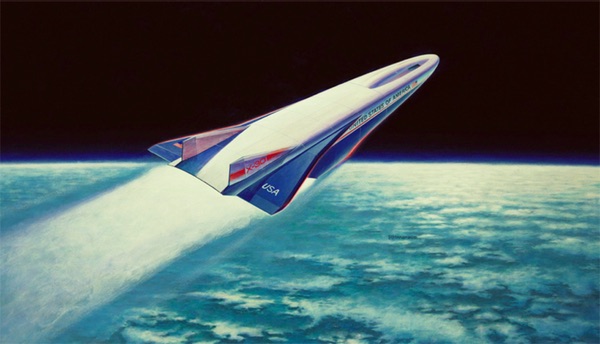 Illustration of the X-30. |
In the 1980s, the United States undertook developing the National Aerospace Plane (X-30). The X-30 was to be a single-stage-to-orbit, fully-reusable aircraft. While expendable launch vehicles were being sized primarily by static loads, the X-30 was to be sized for a defined life of usage involving multiple flights, takeoffs and landings, fuel tank pressurization and thermal cycles, and thermal protection system aerothermal load cycles, among other criteria. In other words, is was to be reusable in the aircraft sense of this term. As a reusable aircraft, most of it would be sized by damage tolerance and durability requirements, not just static strength.
For the X-30, a considerable amount of time was involved with trying to develop a thermal protection system concept that was reusable. Due to the hypersonic airbreathing ascent, the aerothermal environment was much more demanding than, for example, the reentry heating of the Space Shuttle orbiter. Finally, a design using ceramic tiles was proposed. However, the thermal expansion and contraction of the tile in flight meant that it could only be attached using a single bolt at the center of the tile. I asked, “What happens when the bolt comes loose or breaks?” It was back to the drawing board. This is a simple example of one aspect of damage tolerance—designing the system to undergo some level of damage and continue safe operations until mission end or until the damage is detected and repaired.
The intent for the X-30 was that it would be airworthiness certified using Air Force procedures just like any Air Force aircraft. Of course, the X-30 was never built due to unresolved technical issues. But, experience with the X-30 shows that this approach can be applied to achieve airworthiness certification of all crewed, reusable space access systems intended for commercial human operations provided, of course, that they are properly designed with airworthiness certification in mind from day one.
Some companies are now mentioning “reusability” as a characteristic of their human space transportation system. This was done several times in the first council meeting. However, there was no mention of the need for airworthiness certification. Consequently, I expect that some “reusable” system designs will not be capable of achieving airworthiness certification even though the system may be reusable in the sense that it can be fueled and reflown again. Thus, it is quite possible that some or all of the systems now in development may not be suitable for future passenger space transportation and habitation because they are being developed without the appropriate safety criteria, analyses, tests, demonstrations, and inspections needed to achieve independent airworthiness certification. Instead, they may be expecting the federal government to permit an “informed consent” approach.
When reviewing reusable space access concepts, one of my first questions asks what is the underlying structural integrity requirements. These requirements add empty weight to the system over what is estimated using simple static strength criteria. Far too often, the response has been to ask me what I’m talking about. Safety and reusability often have not been considered. Often, the presumption is, wrongly, that safety and reusability can be “tested” into the system. From my experience, when structural integrity and other airworthiness criteria are factored in, many concepts cannot be pursued. Thus, it is important from the outset to always understand and assess the airworthiness of proposed designs to prevent unwarranted expectations from being developed, especially by senior decision authorities such as the council.
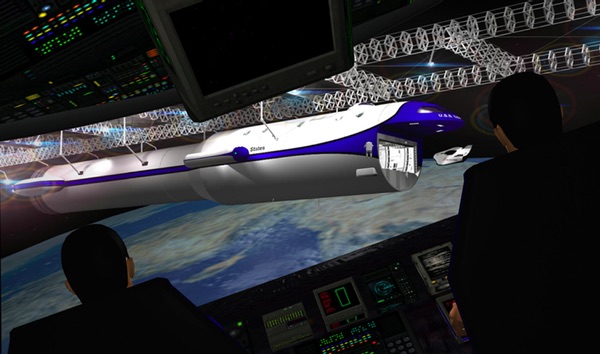 From an arriving spaceship, view of another US spaceship in space dock preparing for departure. This is an illustration of what America’s aerospace industry is now capable of building—a true spacefaring capability. |
America has an exciting spacefaring future ahead. However, to be successful in this national endeavor, we cannot ignore important lessons learned in how we should proceed. Logistics and safety are two necessary foundations for success in transforming America into a world-leading commercial human spacefaring nation. These cannot be afterthoughts. To best address these during the council’s deliberations, two advisory subgroups—one for logistics planning and one for spacefaring safety certification—should be formed, perhaps as part of the general Advisory Group. Also, from the outset, logistics and safety must be part of technical descriptions of proposed future capabilities. This technical information should be available for public review to help build public confidence that America is moving forward wisely.